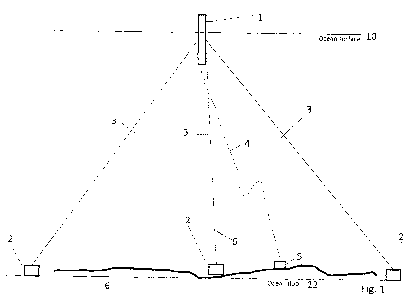Some of the information on this Web page has been provided by external sources. The Government of Canada is not responsible for the accuracy, reliability or currency of the information supplied by external sources. Users wishing to rely upon this information should consult directly with the source of the information. Content provided by external sources is not subject to official languages, privacy and accessibility requirements.
Any discrepancies in the text and image of the Claims and Abstract are due to differing posting times. Text of the Claims and Abstract are posted:
| (12) Patent Application: | (11) CA 2808150 |
|---|---|
| (54) English Title: | OCEANIC COMMUNICATIONS SYSTEM |
| (54) French Title: | SYSTEME DE COMMUNICATIONS OCEANIQUES |
| Status: | Deemed Abandoned and Beyond the Period of Reinstatement - Pending Response to Notice of Disregarded Communication |
| (51) International Patent Classification (IPC): |
|
|---|---|
| (72) Inventors : |
|
| (73) Owners : |
|
| (71) Applicants : |
|
| (74) Agent: | MARKS & CLERK |
| (74) Associate agent: | |
| (45) Issued: | |
| (86) PCT Filing Date: | 2010-09-09 |
| (87) Open to Public Inspection: | 2011-03-17 |
| Availability of licence: | N/A |
| Dedicated to the Public: | N/A |
| (25) Language of filing: | English |
| Patent Cooperation Treaty (PCT): | Yes |
|---|---|
| (86) PCT Filing Number: | PCT/US2010/048198 |
| (87) International Publication Number: | US2010048198 |
| (85) National Entry: | 2013-02-12 |
| (30) Application Priority Data: | |||||||||
|---|---|---|---|---|---|---|---|---|---|
|
A system of buoys (1) is connected by vertical cables (2) to submarine fiber optic communications cable (6) on the ocean floor or in cases where no submarine fiber optic cable is present, the buoys (1) will use satellite communication. The buoys (1) are aligned on the surface of the ocean, underneath heavily traveled oceanic air routes to provide platforms for radios. The satellite or cable connection to the buoys (1) enables high bandwidth communications backhaul from the buoy (1) to the internet or public switched telephone network. The high bandwidth buoys (1) provide a platform to put different radio systems, enabling a substantially uninterrupted radio connection to high altitude aircraft as they transit oceanic airspace.
L'invention porte sur un système de bouées (1) qui est connecté par des câbles verticaux (2) à un câble de communications à fibres optiques sous-marin (6) sur le fond de l'océan ou, dans des cas où aucun câble à fibres optiques sous-marin n'est présent, les bouées (1) utiliseront une communication par satellite. Les bouées (1) sont alignées sur la surface de l'océan, sous des routes aériennes océaniques à fort trafic, de façon à fournir des plateformes pour les radios. La connexion par satellite ou par câble aux bouées (1) permet une retransmission de communications à grande largeur de bande de la bouée (1) vers le réseau téléphonique public ou l'Internet. Les bouées à grande largeur de bande (1) fournissent une plateforme afin de mettre en place différents systèmes de radio, permettant une connexion par radio sensiblement ininterrompue à des avions à haute altitude lorsqu'ils traversent l'espace aérien océanique.
Note: Claims are shown in the official language in which they were submitted.
Note: Descriptions are shown in the official language in which they were submitted.

2024-08-01:As part of the Next Generation Patents (NGP) transition, the Canadian Patents Database (CPD) now contains a more detailed Event History, which replicates the Event Log of our new back-office solution.
Please note that "Inactive:" events refers to events no longer in use in our new back-office solution.
For a clearer understanding of the status of the application/patent presented on this page, the site Disclaimer , as well as the definitions for Patent , Event History , Maintenance Fee and Payment History should be consulted.
| Description | Date |
|---|---|
| Application Not Reinstated by Deadline | 2015-09-09 |
| Time Limit for Reversal Expired | 2015-09-09 |
| Deemed Abandoned - Failure to Respond to Maintenance Fee Notice | 2014-09-09 |
| Inactive: Cover page published | 2013-04-17 |
| Inactive: Notice - National entry - No RFE | 2013-03-15 |
| Application Received - PCT | 2013-03-15 |
| Inactive: First IPC assigned | 2013-03-15 |
| Inactive: IPC assigned | 2013-03-15 |
| National Entry Requirements Determined Compliant | 2013-02-12 |
| Application Published (Open to Public Inspection) | 2011-03-17 |
| Abandonment Date | Reason | Reinstatement Date |
|---|---|---|
| 2014-09-09 |
The last payment was received on 2013-08-26
Note : If the full payment has not been received on or before the date indicated, a further fee may be required which may be one of the following
Patent fees are adjusted on the 1st of January every year. The amounts above are the current amounts if received by December 31 of the current year.
Please refer to the CIPO
Patent Fees
web page to see all current fee amounts.
| Fee Type | Anniversary Year | Due Date | Paid Date |
|---|---|---|---|
| MF (application, 2nd anniv.) - standard | 02 | 2012-09-10 | 2013-02-12 |
| Basic national fee - standard | 2013-02-12 | ||
| Reinstatement (national entry) | 2013-02-12 | ||
| MF (application, 3rd anniv.) - standard | 03 | 2013-09-09 | 2013-08-26 |
Note: Records showing the ownership history in alphabetical order.
| Current Owners on Record |
|---|
| BRETT A. PLENTL |
| Past Owners on Record |
|---|
| None |